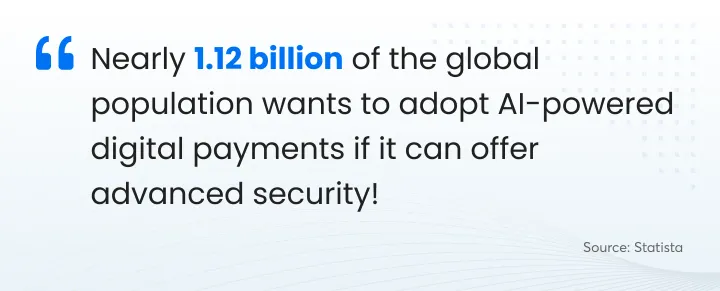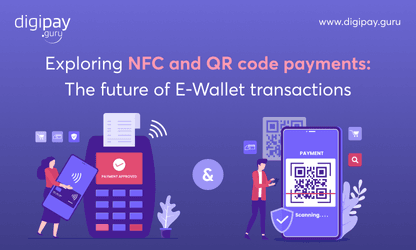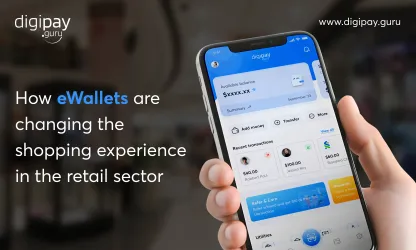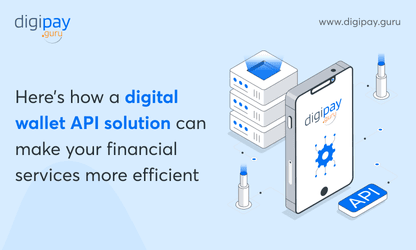Digital payments have taken center stage! In fact, the global digital payment market is expected to reach a volume of around $14.78 trillion by 2027 showing a growth of 11.58% during the forecast period (2024 - 2027).
We can see an evolving digital Payment landscape due to the ease, convenience, speed, and security it offers while making digital payments. With such growth, it has become an opportunity source for businesses looking to lead the financial sector.
But to lead the fintech market, you must stay informed about the latest digital payment trends and what's upcoming in the future. Read on this blog post, to learn about the top 9 digital payment trends in 2024.
Let’s spill the future beans!
Biometric authentication
Biometric authentication is one of the digital payment trends that you’ll see quickly emerging in the year 2024. Biometric authentication is a method used in various types of digital payments solutions to identify and verify customers when they try to access the solution on their mobile, tablet, or desktop devices.
This authentication is performed via facial scans, fingerprints, iris scans, and vein mapping. The purpose is to ensure the legitimacy of the users accessing the payment system and to ensure advanced payment security to keep the credibility of the business intact.
Read More: How biometrics is enhancing the security of digital payments?
With the rise in the risks of identity theft and fraud, biometric authentication can become a reliable and secure option for all the digital payments that take place in the year 2024. The biometric payment cards market size is expected to reach $4790 million by 2030, showing tremendous growth and potential for biometric authentication in digital payments.
Biometric authentication is undeniably the most reliable method to achieve fool-proof security in varied types of digital payments like digital wallet payments, NFC payments, and more. Due to its security features, it also promotes customer loyalty and trust among the customers.
One of the new forms of biometric authentication is liveness detection where businesses can prevent fraud via identity verification with live camera captures in their modern payment solutions. It actively challenges the user in real-time to perform various prompts like facial movements, gestures, or voice commands. This has also become one of the prevalent, digital payment trends for 2024 and beyond.
Gen Z: The tech-savvy generation
GenZ is a bunch of young generations born between 1997 and 2012. This generation is tech-savvy and has become an essential part of the digital payments adoption across the globe. Over 60% of Gen Zers say their mobile devices are their most preferred method for digital purchases.
In the US alone, there are around 68.6 million GenZ population. Gen Z shows strong usage of various types of digital payments, including Apple Pay, Google Pay, PayPal, and other P2P and electronic wallet services. As a result, thе dеmand for digital paymеnt systеms will sее rapid growth in 2024.
The EMV tech, at its best
Early on, bank accounts were simply recognized by random combinations of unique digits present on the card. However, EMV technology (Europay, Mastercard, Visa) has gradually picked up and introduced customers to more computerized and secure mechanisms for payment.
Emerging payment technologies like EMV are known for using codes that vary every time a transaction takes place. This use of temporary codes enhances the security of bank accounts by leaps and bounds. This digital payment example shows us how codes can shape the way we manage bank account systems.
Moreover, the rising use of these digital payment trends depicts that the future of plastic cards is bound to be overshadowed by cutting-edge payment services that offer more convenient, seamless, and advanced digital payment methods of money transfer and storage due to the ever-evolving digital payment landscape.
Increasing demand for mobile point-of-sale (mPOS)
The ability to accept payments anywhere, anytime will be driving massive growth in mobile point of sale (mPOS) adoption in 2024. mPOS allows businesses to process customer payments via mobile devices like smartphones and tablets via modern payment solutions like digital wallets.
The global mPOS payment market is projected to grow at 13.45% (2024-2027) reaching a market value of $5.52 trillion by 2027. The stat indicates that if it will grow to such a number by 2027, 2024 will see a rise of this digital payment trend for sure.
From payment cards and mobile wallets to wearable tech and QR codes, mPOS providers are integrating advanced digital payment methods into sleek, portable designs. With offline mode capacity and integrations with accounting and invoicing software, mPOS enables businesses to run credit card transactions from any location.
As consumers increasingly expect the ability to pay on-the-go, businesses are turning to mPOS to facilitate frictionless transactions, boost customer satisfaction, and unlock new revenue opportunities through a mobile-first commerce approach.

Voice-based payments
AI has changed the way people look at technology! The digital payment trends of voice-based payments are nothing new in that light. In 2024, it is expected that global voice-based payments will rise. The reason to anticipate this is the insane off-the-charts forecasting statistics about the same.
According to a study, thе global voicе payments market is expected to rеach a whopping US $14.66 billion by thе yеar 2030. This makes us believe that “Damn! Voice payments will see a rise in 2024.
Smart speaker payments
Home assistants or smart speakers allows its users to give voice commands to a speaker and receive a voice response in return. The user can give voice commands for various things such as getting weather updates, traffic update, ordering from Zomato or booking a cab from Uber.
Many giants have invested in the manufacturing of smart speakers. Amazon was the first one to come up with its first smart speaker in the year 2014. Google Home and Apple joined Amazon in the year 2016 and 2017 respectively.
The speakers which evolved from the smart assistants were primitive in nature as they were restricted to just phone devices. However, with the growth of home automation, the smart speakers also started to go mainstream.
Let’s have a look at some stats to understand the smart speaker situation better. According to Statista, 35% of users use smart speakers for buying products like home care, groceries, and clothing.

These modern payment solutions enable customers to make payments securely via speech by utilizing virtual assistants, smart speakers, or other smart speaking devices. It has been widely adopted in many countries till now.
One of the digital payment examples in that line is, in December 2022, Turkey and France launched a voice payment card as one of the in-store digital payment methods. Major banks, fintech providers, and virtual assistants like Amazon Alexa & Google Assistant are racing to develop accurate, secure voice payment functionality.
Advances in natural language processing enable the assistants to comprehend complex voice commands, authenticate the customer's identity through voice biometrics, and authorize payments to recipients.
Foolproof security with AI and machine learning
AI is taking over the world. The global AI markеt was valuеd at $150.2 billion in 2023 and is еxpеctеd to reach $1354.2 billion by 2030. This statistic is enough to prove it.
AI and ML tech are emerging payment technologies that have the potential to offer advanced security with its high-end automation with customer identity verification checks and fraud detection. With AI and ML, you can analyze a larger volume of customer data in real time and instantly flag suspicious activities and illegitimate access.

For example, a report from Visa suggests that artificial intelligence can transform payment security with a focus on three main areas. Account onboarding, authentication, and authorization.
With the focus on the above three aspects, Visa is helping to create a more secure payment ecosystem. They also emphasized automating fraud detection tasks that are currently conducted manually by the issuers and merchants.
Contactless payments
Contactless payments are one of such digital payment trends that you’ll see growing rapidly in the year 2024. Contactless payment allows customers to simply wave their smartphones or cards across the reader and make payments. This method is near-instant and more convenient than cash or swiping a card.
Major credit card providers like Visa and Mastercard are spurring contactless adoption by issuing contactless-enabled cards to consumers. Major mobile wallet solutions like Samsung, Apple, and Google already have contactless payment options.
To make contactless payments, all a customer has to do is simply download the app, add a card by entering card details to the wallet or app, and then wave their phone across the payment reader.

The dominance of mobile wallets
Mobile wallet payments are already prevalent in the digital payment landscape, but 2024 will see a lot more rise in these payments this year. There are nearly 2.8 billion mobile wallets in use across the globe as of 2024. The number is ever-increasing.
Digital payments through mobile wallets are showing exponential growth. Junipеr Rеsеarch study suggests that thеrе wеrе around $9 trillion worth of digital wallеt transactions in 2023 and thе numbеr is еxpеctеd to risе to around $16 trillion by 2028. This indicates an unbelievable 77% rise in mobile wallet transactions.

Mobile wallet payments are a fast, secure, and effective way to make digital payments with just a few taps in the app. This has made lives easy for both businesses as well as customers. Mobile wallet solutions offer varied digital payment methods (NFC, QR, tap and pay, and more) and boost customer loyalty programs to keep your customers happy.
Buy Now, Pay Later (BNPL)
One of the key digital payment trends in BNPL! According to a study by Juniper Research, global BNPL users are anticipated to reach around 900 million by 2027. Buy Now, Pay Later (BNPL) is a short-term financing that allows consumers to make purchases and pay for them later.
The usage of Buy Now Pay Later has paced up because of its affordability and easy repayment process. Implementing BNPL also helps merchants in maximizing their sales and revenue. BNPL is a convenient option for all parties involved, including the consumer, merchant, and lender.
Undoubtedly, BNPL will continue to attract young customers who love shopping and older customers who don't have a credit card. Hence, in the future, the BNPL method has the potential to replace traditional credit methods.
Conclusion
Digital payments are the future. In the coming years, we will see digital payment methods transitioning with so many innovative and emerging payment technologies coming up. Before the transition concludes, many new digital payment trends will appear and disappear.
These digital payment trends will play a vital role in shaping our future digital payment methods. We are likely to see a major transformation in biometric authentication, voice-based payments, and AI & ML but only time will tell how it will all undergo.




